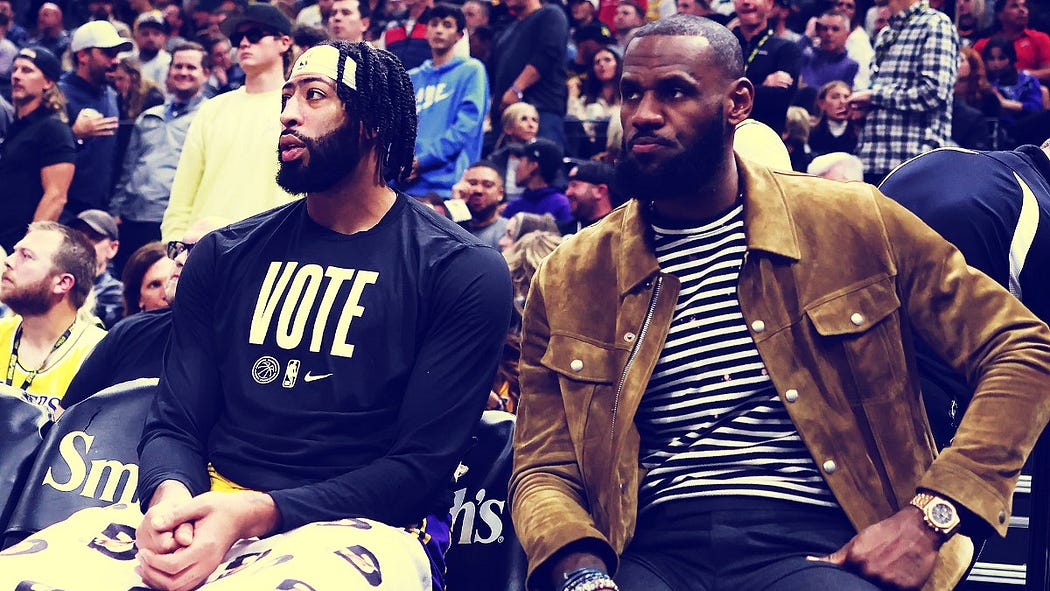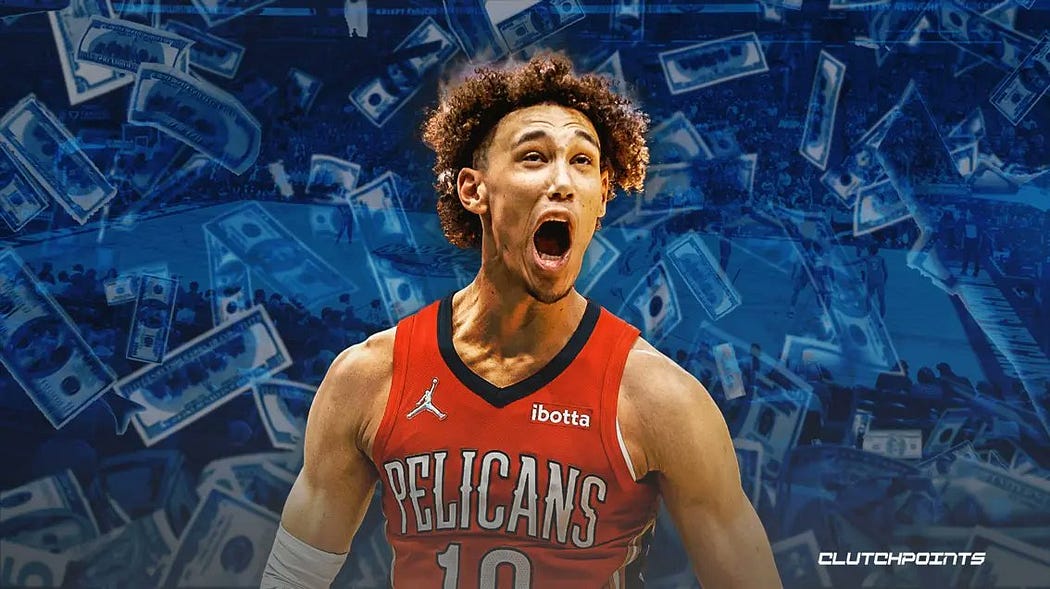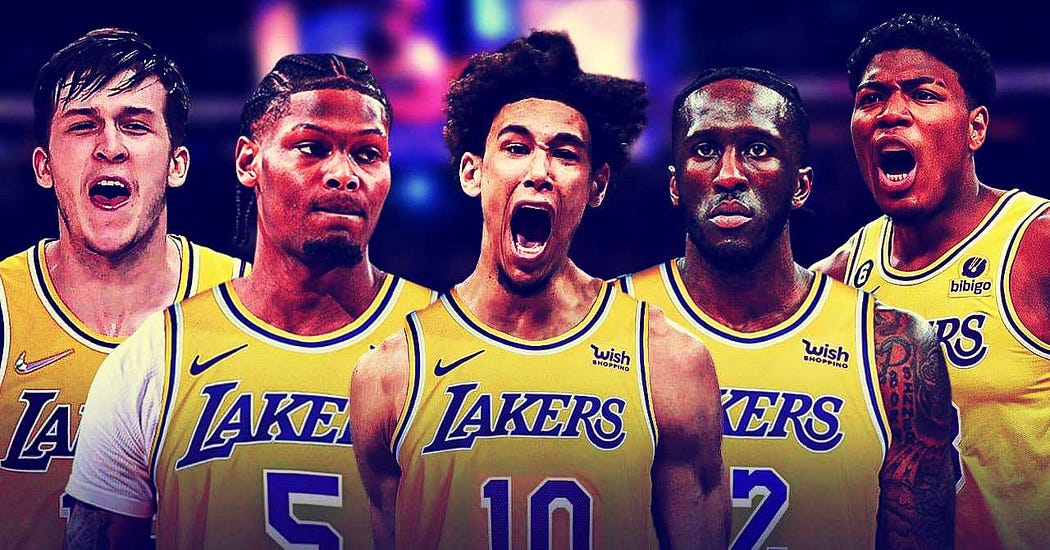The Lakers have surrounded superstars LeBron James and Anthony Davis with an impressive collection of battle-tested young talent that can not only win now but also be part of building championship rosters for the future.
While the Lakers are bringing back all 5 starters and 2 of 5 main backups, they’re also relying on a new untested backups at point guard in Gabe Vincent, small forward in Taurean Prince, and center in Jaxson Hayes. Vincent should be an upgrade over Schroder and Prince finally means the Lakers will have a solid 3&D wing to back up LeBron. The gamble is Jaxson Hayes as the backup center. Can he just do what Lakers need him to do?
Additionally, the Lakers are counting on an untested 20-year old second year guard Max Christie to backup shooting guard. While the Lakers have a lot of upside to like in their backups, they also are vulnerable to wild cards. Wild cards are potentially game changing factors that could either propel or derail a season: supposed strengths that turn into weaknesses when stressed or vulnerabilities that get taken advantage of when exposed.
On paper, the Los Angeles Lakers have made a series of moves ‘on the margins’ to improve their roster size and depth. Whether that translates to the Lakers winning a championship will depend on these five wild cards.
1. Health

When both of your two superstars have missed significant parts of the last three seasons due to injuries, health has to be the single most important wild card that could either propel or derail the Lakers’ 2023–24 season.
The Lakers took smart steps this offseason as insurance against LeBron James or Anthony Davis possibly suffering an injury by getting bigger, deeper, younger, and less reliant on their superstars carrying the load. Strategically, the Lakers hope a deep, diverse, and talented roster could prevent the team from having to overly rely on LeBron James and Anthony Davis to the point where they’re overplayed and, as a result, injured.
LeBron and the Lakers have always been reluctant to fully embrace load management as as strategic priority but the time has come for them to consider setting limits of 30 minutes per game on both James and Davis. That doesn’t mean you can’t break the rule to win a specific game or change it in the playoffs. It just means that you want to wean the team from over relying on their superstars and limit superstar minutes to prevent injuries.
Hopefully, embracing load management will be the wild card that enables the Lakers to keep LeBron James and Anthony Davis fresher and injury free during the long regular season and ready to thrive in the playoffs.
2. Youth

The Lakers’ second biggest wild card is their heavy reliance on youth with 20-year old shooting guard Max Christie and 23-year old center Jaxson Hayes projected as Austin Reaves’ and Anthony Davis’ primary backups.
Those are two major rotation roles that will require leaps in the growth and development of young Max Christie and Jaxson Hayes. While only 20 years old, the Lakers are confident Christie is ready for a role in the rotation. While he’s only in his second year, Max’s game’s already taken a huge leap per his summer league play, showing why the Lakers are justified to have him penciled in the 10-man rotation with which they’ll start this season.
Hayes is a bigger question mark as he was unable to hold a rotation spot in New Orleans despite elite athleticism, talent, and size. Jax realizes this is a great opportunity for him but he will need to focus on protecting the rim. The Lakers believe Hayes could be their center of the future and envision him at some point starting alongside Anthony Davis as the team returns to the two bigs lineups that won the 2020 NBA championship in the bubble.
The Lakers are asking a lot of 20-year old Christy and 23-year old Hayes and will bring them along slowly as key pieces in the rotation. It would be a big wild card for the Lakers if the young Max and Jax can grow into their roles.
3. Size

Size is another Lakers’ wild card. One of their goals this summer was to get bigger at every position: in the backcourt, on the wings, and even at center where they would like to return to the 2020 championship two-bigs model.
The Lakers added 6′ 11′ Hayes, 6′ 8″ Prince, 6′ 7″ Reddish, 6′ 7″ Lewis, 6′ 6″ Hood-Schifino, and 6′ 2″ Vincent to go with 6′ 10″ Davis, 6′ 9″ James, 6′ 8″ Vanderbilt, 6′ 8″ Hachimura, 6′ 6″ Russell, 6′ 5″ Reaves, and 6′ 5″ Christie. That’s a big lineup with 9 players with wingspans over 7′. What’s missing, though, are the quicker smaller guards like Dennis Schroder who can beat defenders off the dribble offensively but are a size liability defensively.
Strategically, the Lakers have been able to compensate for their negative 3-point differential by outscoring opponents in the paint and at the line despite their glaring lack of size in front and backcourt all season long.
By getting bigger and more athletic, the Lakers are hoping they’ll be able to build even bigger advantages in points-in-the-paint and made free throws. It’s their formula for how to win in the NBA without great 3-point shooting.
Size is a wild card that often gets trumped by speed and quickness. The Lakers are doubling down that getting bigger and longer will help them increase their advantages in points-in-the-paint and made free throws.
4. Depth

There is no team in the NBA more starpower driven than the Los Angeles Lakers, where superstars and championships have become synonymous. Yet the Lakers opted to add depth rather than starpower this offseason.
For starpower driven teams like the Lakers, depth has usually been filled with over-the-hill veterans on minimum contracts looking for one last hurrah and an opportunity to win a championship ring before they retire. Rather than add a third star, the Lakers spent their limited cap space on adding depth in the form of young, big, long, and athletic players who can not only backup their starters but also grow and develop into starters.
When analysts look at what Rob Pelinka has done in rebuilding the Lakers on the fly, the most astonishing aspect of the accomplishment is how he has surrounded LeBron and AD with nothing but young athletic players. That’s why depth is a wild card that could come back to haunt the Lakers. They not only did not bring in a veteran scorer like Bogdanovic to close games. Instead they invested win-now resources in the future.
Part of the Lakers’ grand strategy is building a team that has a beating and thriving heart of talented young players with promising upsides that is continually replenished. The Lakers’ wild card is inexperienced depth.
5. Continuity

The good news is the Lakers have finally put together a 13-player roster that is maybe one player away from being a championship caliber squad. The bad news is only 7 of the 13 players were from last season’s roster.
Frankly, the Lakers season-closing finish to make the playoffs much less the conference finals was miraculous and maybe unrepeatable when you consider how little time they had playing together to do what they did. That’s why continuity is still a major wild card with this team. On paper, the Lakers look like a much better and deeper team. They do have five starters and two of five primary backups returning so there’s hope they can gell.
Pelinka has now completed 80% of the job of transforming the Los Angeles Lakers from a lottery team to a championship contender. All that remains is adding a big to the current roster and trading for that last puzzle piece. What’s most astonishing about Pelinka’s makeover is what this deep and talented young roster means in terms of the franchise’s sustainability when LeBron James retires. Lakers are positioned to not miss a beat.
While the Lakers have finally committed to building a sustainable deep roster, their current lack of continuity is potentially the team’s greatest wild card. Hopefully, James and Davis leadership will be able to overcome that.